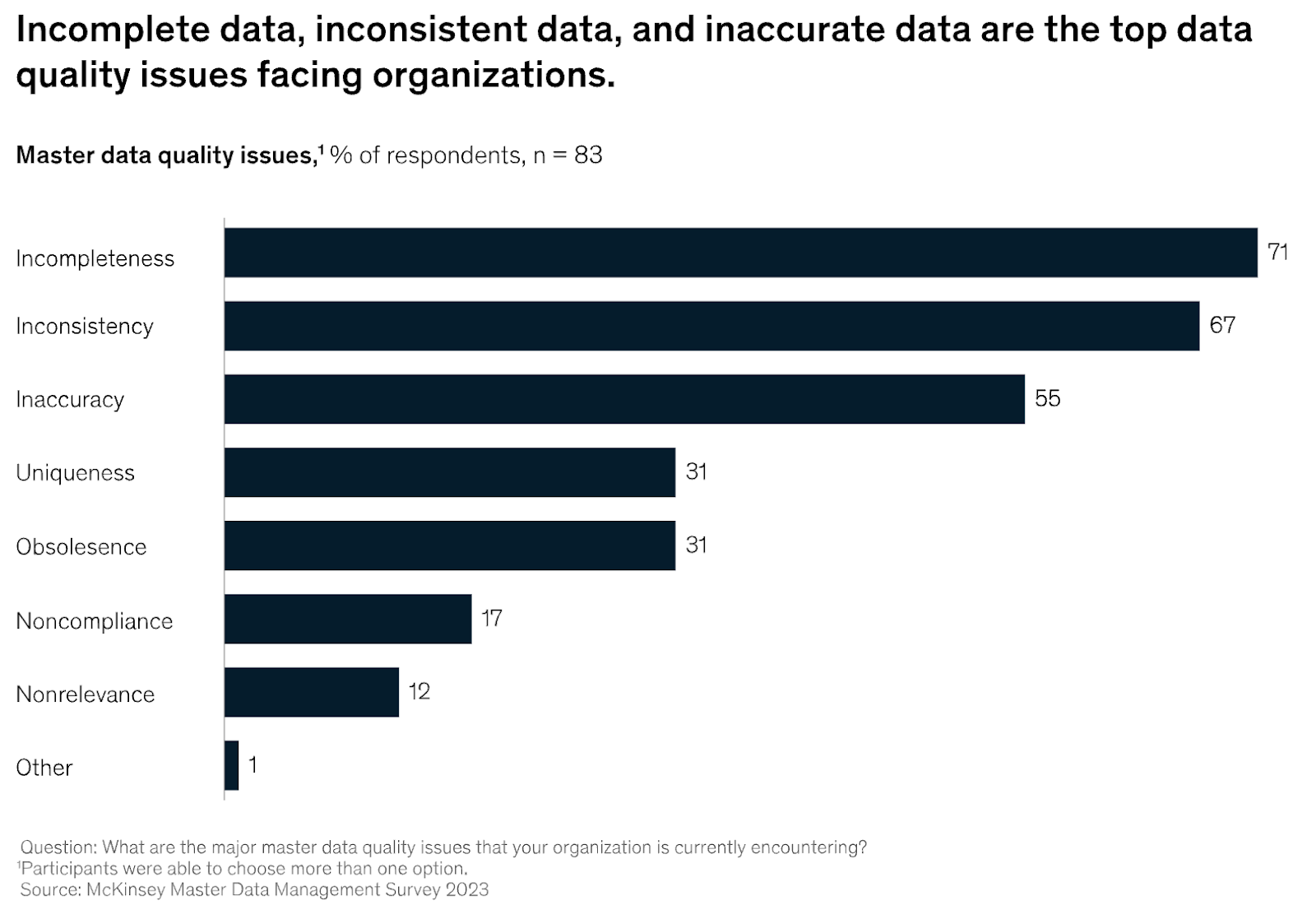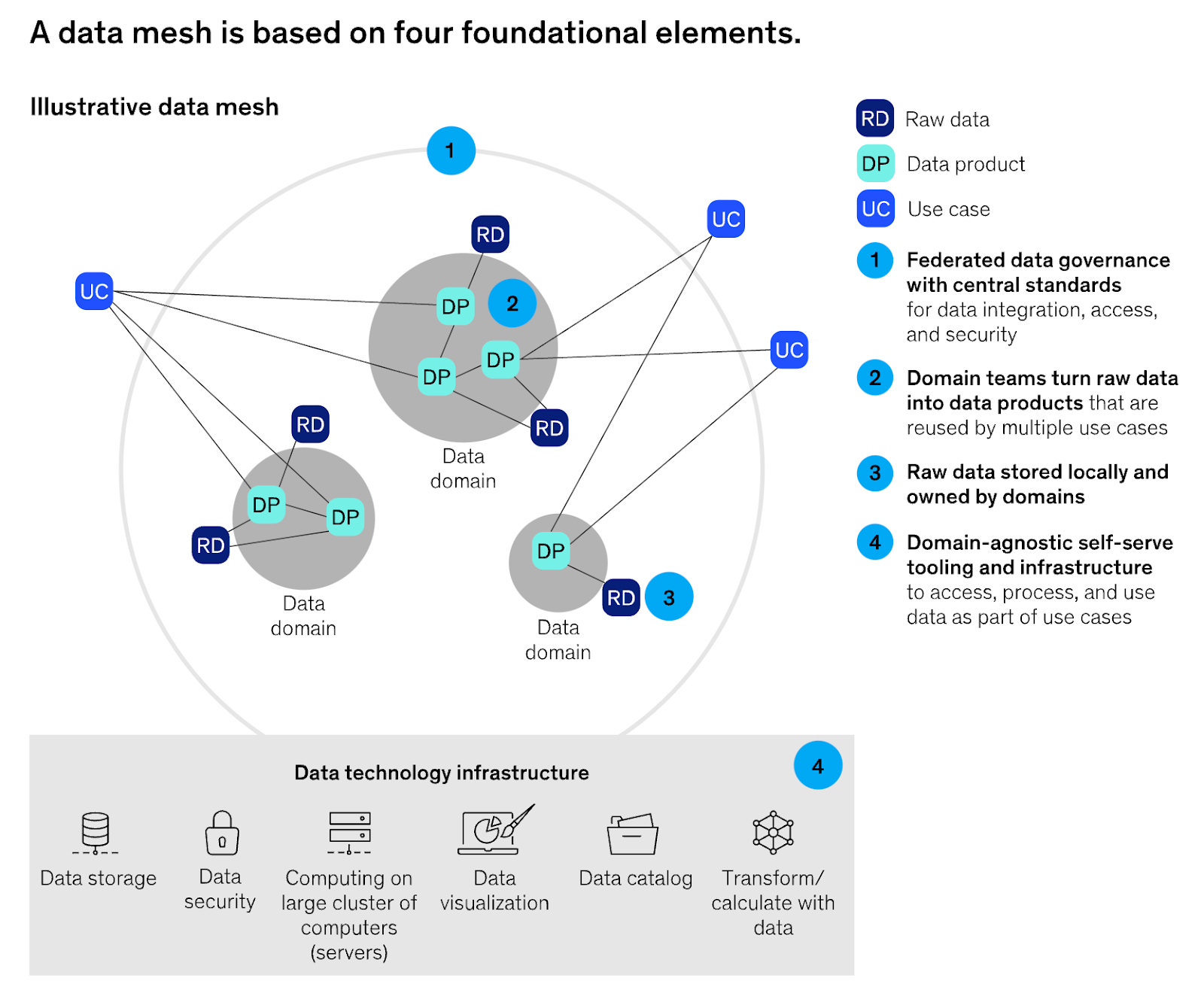Most businesses have accumulated a lot of data, but very few are using their data effectively. How well is your organisation leveraging its data to drive innovation and growth?
Most of the clients I work with struggle to use their data effectively. They either can’t find and use the data they need, or spend so much effort cleaning and fixing it that it becomes a constraint rather than an asset.
Strengthening master data management (MDM) is a fundamental enabler for businesses to improve their current performance and position themselves for future growth. And it’s not that hard to do.
What Is MDM?
Master data management is a process of governing, cleansing, and standardizing your most critical data, to ensure it is accurate, complete, and consistent.
Types of master data include:
- Customer
- Client data
- Product
- Supplier
- Financial
- Employee
- Asset
83% of organizations consider client and product data to be the most dominant domains, as these are core to revenue generation. Client data is critical for B2B businesses to tailor client strategies and communications to optimise marketing and sales effectiveness. Likewise, product data is used across supply chain, sales and R&D, underpinning both business productivity and growth.
Why Is MDM Important?
Master data management is critical for businesses to leverage the power of their data to its best advantage. Data-driven insights can be used for everything from improving the customer experience to increasing revenue through cross-selling and upselling. Those insights, obtained through data and data analytics, all are reliant upon your business having accurate, complete data — which is what MDM can provide.
Another key benefit of MDM is increased operational productivity and efficiency. It eliminates data silos, solving the problem of fragmented, disparate information, residing in different software programs used by different teams through the creation of “golden records.” These records provide a single source of truth, which puts the right information at the fingertips of whichever team needs it. This also streamlines and improves the accuracy of reporting, reducing the effort and improving the ability to satisfy data compliance requirements such as GDPR, PIPL, HIPAA or the Australian Privacy Act.
The Cost of Poor MDM
82% of organisations spend one or more days per week resolving data quality issues. 66% of organisations use manual reviews to manage data quality. This is an expensive waste of resources.
The top causes of poor data quality are incompleteness, inconsistency and inaccuracy issues. These undermine digital transformation and drive:
- Customer dissatisfaction
- Operational inefficiency & costs
- Privacy & security risk
- Poor business decisions

(Source: McKinsey, 2023 1)
Without accurate, reliable data you risk sending customers the wrong message, sending them messages that have incorrect information, or missing the engagement opportunity completely. Either way, your customer will feel unloved and not trust you.
Poor data quality also creates processing errors and generates rework for your team (and maybe also your customer?). In addition to wasted effort and cost, it slows your productivity and undermines your competitiveness. Basing your business decisions on inaccurate or incomplete data can also be a costly exercise, leading to poor investment decisions and wasted opportunities. But perhaps one of the most concerning outcomes of poor data quality is the privacy and security risk it creates. Without a solid handle on your data, you are limited in your ability to provide certainty that sensitive data is masked appropriately or that access is adequately controlled.
Only 29% of organisations have full integrations between source systems and business applications, as well as all governance or stewardship roles, in place 1.
What Good MDM Looks Like
Good MDM requires a data management solution that easily integrates into your existing technology environment, and is flexible and scalable to accommodate future growth and innovation. This solution will help you establish data standards, documentation, and taxonomies, plus put in place business-led data stewardship and federated governance.
One of the leading approaches to managing your data is using a “data mesh” approach (illustrated below). The source data is curated locally by the “owning” business unit (the stewards of the data), who turn the data into a usable “product.” These data products are then made accessible to the broader business, ideally through self-service tools, to benefit business process use cases across the organisation. While data governance and stewardship is localised, data integration, access and security standards are centralised to ensure consistency and reliability. Thus data quality is maintained at a “single source of truth” and is available in a useful and consistent way for the broader business to consume.

(Source: McKinsey, 2023 2)
By leveraging your data as a product and enabling self-service, you are achieving:
- Faster time-to-market for data-driven products
- Increased business agility and innovation
Does MDM Really Work?
Yes, MDM really does work! Businesses everywhere have benefited from improving their data quality. In Australia, a $2B+ market-leading organisation, ranked in the top 10% globally, has used Boomi Data Hub to drive efficiencies company-wide by creating common, consistent views of its critical data. With Boomi Data Hub, the organisation was able to cleanse, deduplicate, and synchronise data from multiple sources to provide an accurate and reliable data set.
Providing a single, accessible, consistent view of core data has created many business benefits for this organisation, including:
- A single source of truth allows identification and correction of data discrepancies between systems (which were previously hidden, generating unidentified data errors).
- The common “master data” record is easily accessible and avoids different teams sourcing the same data from different systems in different ways. This avoids duplicating effort, creating complexity, technology debt and security risk. Not to mention unnecessarily resource consumption and expense. eg. All central business units were previously doing their own data sourcing, cleansing and interpretation.
- Visibility allows business users to see what data is available, in a common language, accelerating the requirements and design stages, saving months of project duration (and associated costs). Data governance and accessibility typically takes more time than the technical solution.
- These common data sets are being used across 80% of the company’s business projects, decreasing the time to access data by more than 25% (from months to weeks) and reducing effort and expense across the organisation.
- The single view of data also accelerates onboarding of new staff, making them more productive, earlier. Instead of having to provide access to 6 or 7 different applications, create accounts, secure permissions, learn different technologies, architectures and table structures, staff only need to learn Data Hub and the single version of the data therein. It also reduces access management maintenance and security risks.
- The value of any improvement in the source data is multiplied by the number of downstream integration and systems which consume the data, as the owning business units no longer need to waste time in duplicate effort correcting errors.
Boomi Data Hub has also proven to be a key enabler for strategic initiatives which would have been far more complex and costly — and would have taken much longer — if the organisation had sourced its core data independently.
Next Steps
To get started on your path to master data management success, the first step is to conduct a quick health check of your data quality. Ask yourself:
- Which are your most critical types of (master) data? Is your data clear enough to identify them?
- Who is the data steward for each? Is data ownership and governance clear?
- Does everyone have access to the data they need?
- Does everyone use data in a consistent way?
- Where does poor data quality represent a risk to my business?
Next, identify all the areas of value leakage that poor data is causing your business. Then make a plan to stem the bleeding. Once you’ve established a data governance structure that identifies clear data ownership and usage responsibilities, you’ll be ready to implement your master data strategy. To make data quality improvement easy, you can leverage a tool like Boomi Data Hub.
Learn how Boomi Data Hub can help you find, understand, and use your data better at boomi.com/platform/hub
—
Sources:
1 – McKinsey, 2023, “Master data management – the key to getting more from your data” https://www.mckinsey.com/capabilities/mckinsey-digital/our-insights/master-data-management-the-key-to-getting-more-from-your-data?stcr=D4FF8351C55047179AC3D604BFCFF3B5&cid=other-eml-alt-mip-mck&hlkid=be9f01faa33a4682808e782b30b50989&hctky=9582909&hdpid=2749ad6c-3b2b-4bfb-a0e1-69bb9344dedb
2 – McKinsey, 2023, “Demystifying data mesh” https://www.mckinsey.com/capabilities/quantumblack/our-insights/demystifying-data-mesh?stcr=4A3D4C16D5ED4D07865645314FE1FA8C&cid=other-eml-alt-mip-mck&hlkid=f634656f85b54fdd880b6c4b631f247d&hctky=9582909&hdpid=2749ad6c-3b2b-4bfb-a0e1-69bb9344dedb


 English
English 日本語
日本語